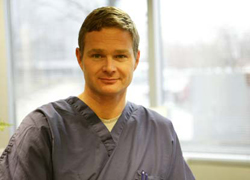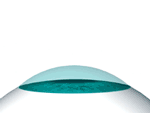
If you’ve been researching LASIK, chances are the 5,000+ brands of LASIK — and the dizzying array of technologies and clinical outcomes — have left you more blurry-eyed than usual. The LASIK Procedure brings it all into focus by simply combining the most advanced LASIK technologies for you.
About LASIK (Laser-Assisted-In-Situ Keratomileusis)
LASIK is the most frequently performed elective surgery in North America. This highly effective outpatient procedure is often referred to as refractive surgery or laser vision correction.
LASIK eye surgery is used to correct the following vision problems: 
- Myopia (Nearsightedness) occurs when your eye is too long in relation to the curvature of your cornea. This causes light rays entering the eye to focus in front of the retina, producing a blurred image.
- Hyperopia (farsightedness) occurs when your eye is too short in relation to the curvature of your cornea. With hyperopia, distant objects are seen more clearly than near objects.
- Astigmatism occurs when your cornea is shaped like an egg. With astigmatism, more than one focal point within the eye distorts what you see. As a result, you experience a tilting of images due to the unequal bending of light rays entering your eyes.Astigmatism
How LASIK Works
The LASIK procedure is performed by ophthalmologists, medical doctors who specialize in surgical treatments of the eye. Here is a general outline of the procedure:
- Anesthetic eye drops are applied to the eye.
- The LASIK surgeon creates a protective flap to access the inner corneal tissue. During this part of the procedure, your vision dims and becomes blurry for about a minute. After the flap is created you are able to see the flashing fixation light of the laser and the bright lights used for the procedure.
- Next the inner layers of your cornea receive computer-controlled pulses of cool laser light. Although the laser light is invisible, the laser makes a clicking sound as it gently reshapes the inner corneal layer to improve and in many cases, eliminate your prescription. During this part of the procedure, an eye-tracking device tracks your eye movements to ensure precise correction.
- Following the re-shaping of the tissue, the LASIK surgeon carefully repositions and aligns the flap to its original position. Protective shields are placed over your eye to prevent accidental rubbing as the flap heals naturally and securely over the next several hours.
After the LASIK eye surgery procedure, patients feel moderate discomfort and irritation for a few hours, but most are comfortable after a nap and rest.
Other Types of LASIK
Everyone’s eyes are different. A pre-procedure consultation with your doctor will help determine the right type of laser eye surgery for you.
- Custom LASIK is a laser vision correction procedure that helps your surgeon customize the laser treatment to your individual eyes. This procedure may result in your vision being clearer and sharper than ever before.
- Bladeless LASIK uses a gentle laser to create a precise, uniform corneal flap. As the name implies, no blades are used in this customizable eye surgery.
Wavefront Technology creates a customized map of the unique attributes of your visual system that transfers to the laser, enabling your LASIK surgeon to address your individual visual requirements. Wavefront technology is used in custom LASIK surgery, including custom bladeless LASIK.
